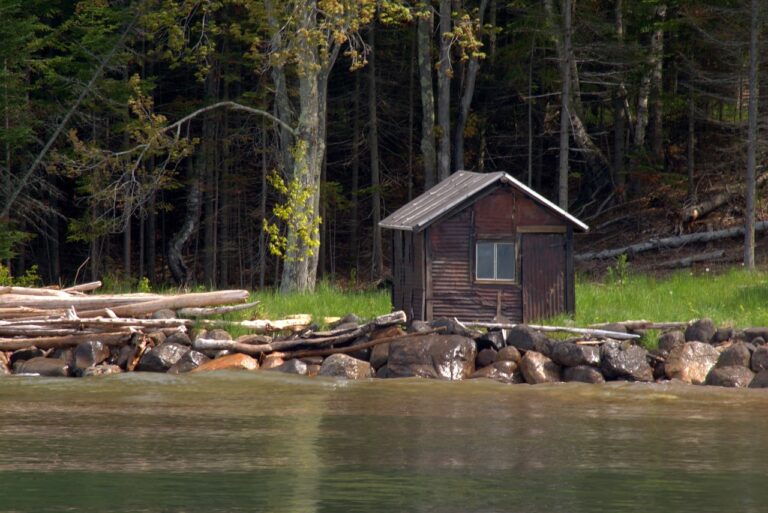Is Going Off the Grid Worth It?
Imagine waking up to the sound of birds chirping, not the hum of the city, and having the freedom to live life on your own terms. Off-grid living has become increasingly appealing to those seeking a more sustainable and self-sufficient lifestyle.
But what does it really mean to live off the grid, and is it a viable option for you? As more people consider ditching traditional utilities and embracing a simpler way of life, the question remains: is this radical change worth the challenges it presents?
As we explore the world of off-grid living, we’ll delve into the benefits and challenges that come with it, helping you decide if this path is right for you.
Key Takeaways
- Understanding the basics of off-grid living
- Exploring the benefits of a self-sufficient lifestyle
- Common challenges faced by off-grid residents
- Assessing whether off-grid living is right for you
- Practical tips for transitioning to off-grid living
What Does Going Off the Grid Really Mean?
Off-grid living is a lifestyle choice that encompasses a range of practices aimed at achieving self-sufficiency. It involves generating your own energy, collecting and conserving water, and often growing your own food. This lifestyle is not just about disconnecting from public utilities; it’s a holistic approach to living that can have various environmental, financial, and social implications.
Defining Off-Grid Living in Modern Context
In today’s context, off-grid living is facilitated by advanced technologies such as solar panels, wind turbines, and sophisticated water purification systems. These innovations make it more feasible for individuals to live off the grid without sacrificing modern comforts.
Spectrum of Off-Grid Lifestyles
The off grid lifestyle can vary significantly from one person to another. Some people choose to live entirely off the grid, while others may only adopt certain aspects, such as renewable energy or organic gardening. This spectrum allows individuals to tailor their lifestyle to their needs and capabilities.
Common Misconceptions About Off-Grid Living
One common misconception about living off the grid is that it’s primitive or unsustainable. However, with modern technology, off-grid homesteading can be both eco-friendly and comfortable. Another misconception is that it’s only for those living in remote areas; urban off-grid living is also possible with the right strategies.
Understanding the nuances of off-grid living is crucial for those considering this lifestyle. It’s not just about being disconnected from public utilities; it’s about embracing a more sustainable and self-sufficient way of life.
The Growing Popularity of Off-Grid Living
Off-grid living is gaining traction across the United States, driven by a desire for sustainability and independence. This lifestyle choice is not just about disconnecting from public utilities; it’s a movement towards a more resilient way of living.
Statistical Trends in the United States
Recent data indicates a significant increase in the number of Americans adopting off-grid living. The trend is driven by a combination of factors, including environmental concerns and the desire for self-sufficiency.
Demographics of Those Choosing to Go Off-Grid
The demographics of off-grid residents are diverse, ranging from young families to retirees. Common characteristics include a commitment to sustainability and a willingness to adopt new lifestyles.
Cultural Shifts Driving the Movement
The off-grid movement is part of a broader cultural shift towards more sustainable and autonomous living. As awareness of environmental issues grows, so does the appeal of off-grid living as a viable alternative to traditional lifestyles.
Is Going Off Grid Worth It? Evaluating the Core Question
The decision to go off-grid is complex, involving a delicate balance of financial, lifestyle, and environmental considerations. As individuals ponder this significant lifestyle change, they must weigh the various factors that influence the viability and desirability of off-grid living.
Financial Considerations
One of the primary concerns for those considering off-grid living is the financial implication. The initial investment in renewable energy systems, such as solar or wind power, and infrastructure like water collection and waste management, can be substantial. However, these costs are often offset by long-term savings on utility bills and potential increases in property value. It’s essential to conduct a thorough cost-benefit analysis to determine whether the financial aspects of off-grid living align with one’s economic situation and goals.
Key financial factors to consider include:
- Initial setup costs for renewable energy and infrastructure
- Ongoing maintenance and potential repair costs
- Potential savings on utility bills
- Impact on property value
Lifestyle Impact Assessment
Off-grid living often requires significant lifestyle adjustments, including changes in energy consumption habits, water usage, and waste management practices. While some individuals may find the increased self-sufficiency and connection to nature rewarding, others may struggle with the loss of modern conveniences and the need for constant maintenance. It’s crucial to assess whether the lifestyle changes associated with off-grid living are compatible with one’s personal preferences and priorities.
Environmental Footprint Analysis
A significant motivation for many individuals considering off-grid living is the desire to reduce their environmental footprint. By generating their own renewable energy and managing their resources sustainably, off-grid residents can significantly decrease their reliance on public utilities and lower their carbon emissions. However, it’s also important to consider the environmental impact of the off-grid systems themselves, including the production and disposal of renewable energy technologies.
The environmental benefits of off-grid living can be substantial, but they must be carefully managed to maximize their positive impact.
In conclusion, whether going off-grid is worth it depends on a variety of factors, including financial readiness, lifestyle adaptability, and environmental consciousness. By carefully evaluating these aspects, individuals can make an informed decision that aligns with their values and goals.
The Financial Reality of Off-Grid Living
Understanding the financial reality of off-grid living is crucial for those considering this lifestyle change. It’s not just about disconnecting from public utilities; it’s a significant financial commitment that involves various costs and potential savings.
Initial Investment Requirements
The initial investment for setting up off-grid systems can be substantial. This includes costs associated with solar panels or wind turbines for energy generation, water collection and purification systems, and waste management solutions. For instance, installing a solar panel system can range from $15,000 to $30,000 or more, depending on the size and quality of the equipment. To learn more about the costs associated with off-grid water systems, you can visit this resource.
Ongoing Costs vs. Traditional Living
While the initial costs are significant, the ongoing expenses for off-grid living are generally lower compared to traditional grid-connected living. For example, you’ll save on monthly utility bills, such as electricity and water. However, there may be maintenance costs for your off-grid systems, which can vary depending on the technology used.
Potential for Long-Term Savings
One of the key benefits of off-grid living is the potential for long-term savings. By generating your own energy and collecting your own water, you can significantly reduce or eliminate your monthly utility bills. Over time, these savings can offset the initial investment, making off-grid living a cost-effective option in the long run.
Tax Incentives and Government Programs
There are various tax incentives and government programs available to support off-grid living. For instance, the U.S. government offers tax credits for renewable energy systems, such as solar and wind power. To understand what it means to go off the grid and potentially qualify for these incentives, you can read more on EnergySage. These incentives can help reduce the initial investment and make off-grid living more financially accessible.
In conclusion, while the financial reality of off-grid living involves significant upfront costs, the potential for long-term savings and the availability of tax incentives make it a viable option for many. Careful planning and consideration of the financial aspects are crucial for a successful transition to off-grid living.
Essential Systems for Self-Sufficiency
To live off the grid effectively, one must implement various systems that ensure power, water, and waste management. Self-sufficiency is at the heart of off grid homesteading, requiring a comprehensive approach to daily needs.
Power Generation Options
One of the critical aspects of off-grid living is generating your own power. There are several options available, each with its own set of advantages.
Solar Systems
Solar power is one of the most popular choices for off-grid energy. It involves installing solar panels that convert sunlight into electricity. For those interested in learning more about transitioning to solar power, resources like https://ecoshack.com/how-to-live-off-the-grid/ provide valuable insights.
Wind Power
Wind power is another viable option, particularly in areas with consistent wind patterns. Wind turbines convert wind energy into electricity, offering a reliable source of power.
Micro-Hydro Solutions
For those with access to a stream or river, micro-hydro solutions can provide a constant and reliable source of energy. Micro-hydro systems harness the energy of moving water to generate electricity.
Energy Storage Solutions
Generating power is only half the battle; storing it for later use is equally important. Effective energy storage solutions are crucial for maintaining a consistent power supply.
Battery Banks
Battery banks are a common method for storing excess energy generated by solar, wind, or hydro systems. They allow homeowners to store energy for use during periods of low generation.
Alternative Storage Methods
Apart from battery banks, there are alternative storage methods such as pumped hydro storage or using the grid as a battery in some net metering arrangements. These alternatives can offer additional flexibility and efficiency.
Water Collection and Purification
Access to clean water is essential for any off-grid lifestyle. Implementing a rainwater harvesting system and water purification methods can ensure a reliable water supply.
Waste Management Solutions
Effective waste management is critical for maintaining a healthy and sustainable off-grid lifestyle. This includes composting toilets, recycling programs, and proper disposal of hazardous waste.
Food Production Considerations
Growing your own food is a key aspect of off grid sustainability. This involves planning and implementing a garden or farm that can meet your nutritional needs, using techniques such as permaculture and regenerative agriculture.
Environmental Impact and Sustainability
Embracing off-grid living means adopting a lifestyle that prioritizes environmental sustainability and self-sufficiency. This approach to living is gaining traction as individuals and families seek to reduce their ecological footprint and promote a healthier planet.
Carbon Footprint Reduction
One of the significant benefits of off-grid living is the reduction in carbon footprint. By generating power through renewable sources such as solar or wind energy, individuals can significantly decrease their reliance on fossil fuels, thereby reducing greenhouse gas emissions.
Resource Conservation Practices
Off-grid living encourages the adoption of resource conservation practices. This includes efficient use of water through rainwater harvesting and greywater systems, as well as minimizing waste through recycling and composting.

Sustainable Building Materials
The choice of building materials is crucial in off-grid living. Using sustainable materials such as reclaimed wood, bamboo, and low-carbon concrete not only reduces the environmental impact of the construction process but also contributes to a healthier indoor environment.
Regenerative Land Management
Regenerative land management practices are essential for maintaining the health and productivity of the land. This includes techniques such as permaculture, which involves designing agricultural systems that mimic natural ecosystems, thereby enhancing biodiversity and soil health.
| Sustainability Practice | Environmental Benefit |
|---|---|
| Renewable Energy Use | Reduces carbon footprint |
| Rainwater Harvesting | Conserves water resources |
| Sustainable Building Materials | Reduces environmental impact of construction |
| Regenerative Land Management | Enhances biodiversity and soil health |
Legal and Regulatory Challenges
As the off-grid movement grows, so does the complexity of legal and regulatory issues surrounding it. Off-grid living is not just a lifestyle choice but also a legal status that comes with its own set of challenges.
Zoning Laws and Building Codes
One of the primary legal hurdles off-grid residents face is complying with zoning laws and building codes. These regulations vary significantly across different jurisdictions and can dictate everything from the type of structures you can build to the energy systems you can use.
State-by-State Variations in the US
The United States presents a diverse landscape when it comes to off-grid regulations. For instance, some states like Texas are more lenient with off-grid living, while others have stricter regulations. Understanding these state-by-state variations is crucial for anyone considering off-grid living.
| State | Zoning Laws | Building Codes |
|---|---|---|
| California | Strict regulations on off-grid homes | Requires compliance with state building codes |
| Texas | More lenient, with fewer restrictions | Local jurisdictions may have specific codes |
| Oregon | Supports off-grid living with specific regulations | Compliance with state building codes required |
Navigating Permits and Inspections
Off-grid residents must often navigate a complex process of permits and inspections to ensure their homes comply with local regulations. This can be time-consuming and costly, but it’s a crucial step in avoiding legal issues down the line.
Property Tax Implications
Another important consideration is the impact of off-grid living on property taxes. In some areas, off-grid homes may be eligible for tax incentives or reductions, while in others, they may be assessed differently due to their self-sufficient nature.
Understanding the legal and regulatory landscape is a critical step in the journey to off-grid living. By being informed and prepared, individuals can better navigate the challenges and enjoy the benefits of this sustainable lifestyle.
Psychological and Social Aspects of Off-Grid Living
Embracing an off-grid lifestyle requires more than just a change of address; it demands a profound shift in one’s psychological and social fabric. As individuals and families transition to this unique way of living, they must adapt to new levels of isolation and self-reliance.
Adapting to Isolation and Self-Reliance
One of the most significant psychological adjustments is coping with the isolation that often accompanies off-grid living. Self-reliance becomes a necessity, as individuals must manage their own resources and problem-solving. This shift can be both empowering and challenging.
Building Community Connections
Despite the physical distance between off-grid homes, building and maintaining community connections is crucial. Many off-grid dwellers find innovative ways to stay connected, such as through online forums, local meetups, and cooperative living arrangements. Community support can significantly enhance the off-grid experience.
Family Dynamics in Off-Grid Settings
For families, off-grid living can have a profound impact on dynamics. It often requires a collaborative approach to managing the household and resources. The table below highlights some key aspects of family dynamics in off-grid settings:
| Aspect | Traditional Living | Off-Grid Living |
|---|---|---|
| Resource Management | Centralized utility services | Self-managed resources (e.g., solar, rainwater) |
| Family Roles | Often specialized | More collaborative and flexible |
| Leisure Activities | Varied, including screen time | Often nature-based and hands-on |
As shown, off-grid living can foster a more collaborative and nature-oriented family dynamic. However, it also presents unique challenges that require careful consideration and adaptation.

Practical Steps to Transition Off-Grid
Embracing an off-grid lifestyle involves a series of practical steps that ensure a smooth transition. It’s not just about disconnecting from public utilities; it’s about adopting a self-sufficient way of living that requires careful planning and execution.
Assessing Your Needs and Resources
The first step in transitioning off-grid is to assess your needs and resources. This involves evaluating your energy, water, and food requirements. Consider factors like the size of your household, your daily energy consumption, and the availability of natural resources on your property.
| Resource | On-Grid | Off-Grid Alternative |
|---|---|---|
| Energy | Public Grid | Solar, Wind, Hydro |
| Water | Municipal Supply | Rainwater Harvesting, Wells |
| Food | Supermarkets | Gardening, Livestock |
Developing Essential Skills
Off-grid living demands a range of skills, from basic DIY repairs to food preservation and water purification. Developing these skills is crucial for maintaining your off-grid systems and ensuring your family’s well-being.
- Basic carpentry and plumbing
- Renewable energy system maintenance
- Gardening and food preservation
- Water collection and purification
Creating a Phased Implementation Plan
Transitioning off-grid is often a gradual process. Creating a phased implementation plan helps manage costs and reduces the risk of feeling overwhelmed. Start with one system, like solar power, and gradually move to other areas like water collection and food production.
Finding Mentors and Resources
Connecting with experienced off-grid residents can provide invaluable insights and guidance. Join online forums, attend workshops, and visit off-grid communities to learn from others who have made the transition.
Transitioning to an off-grid lifestyle is a significant decision that requires careful planning, skill development, and a willingness to adapt. By following these practical steps, individuals can make an informed decision about whether going off grid is worth it for them.
Conclusion: Is Going Off the Grid Right for You?
As we’ve explored the various aspects of off-grid living, it’s clear that adopting this lifestyle can be a complex decision, influenced by factors such as financial considerations, environmental concerns, and personal preferences. The off-grid lifestyle offers numerous benefits, including reduced reliance on public utilities and a smaller carbon footprint, contributing to off-grid sustainability.
However, it’s essential to weigh these advantages against the challenges, including significant initial investments in systems like renewable energy and water collection, and potential legal and regulatory hurdles. Understanding the off-grid pros and cons is crucial in making an informed decision.
Ultimately, whether going off the grid is right for you depends on your individual circumstances, priorities, and willingness to adapt to a more self-sufficient lifestyle. By carefully considering your needs and resources, you can determine if the benefits of off-grid living align with your goals and values.







